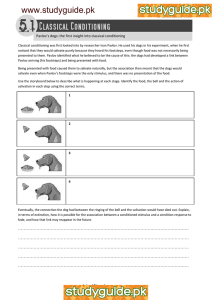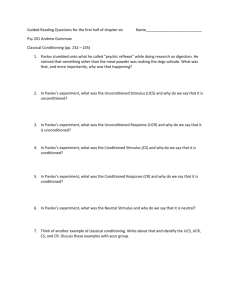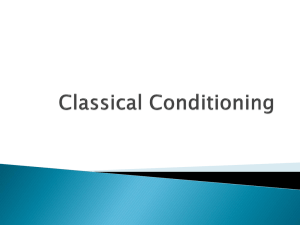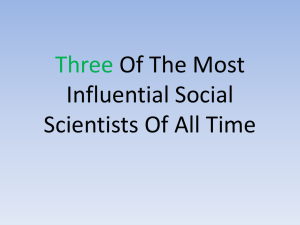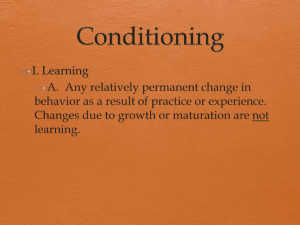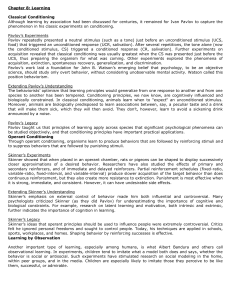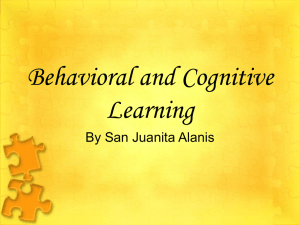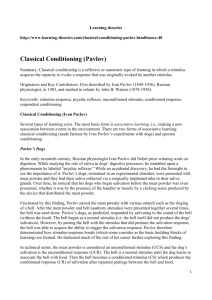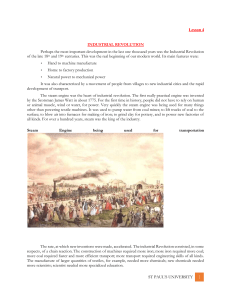Behavioral Learning Theory: Pavlov and Piaget - UHS-CD3
advertisement
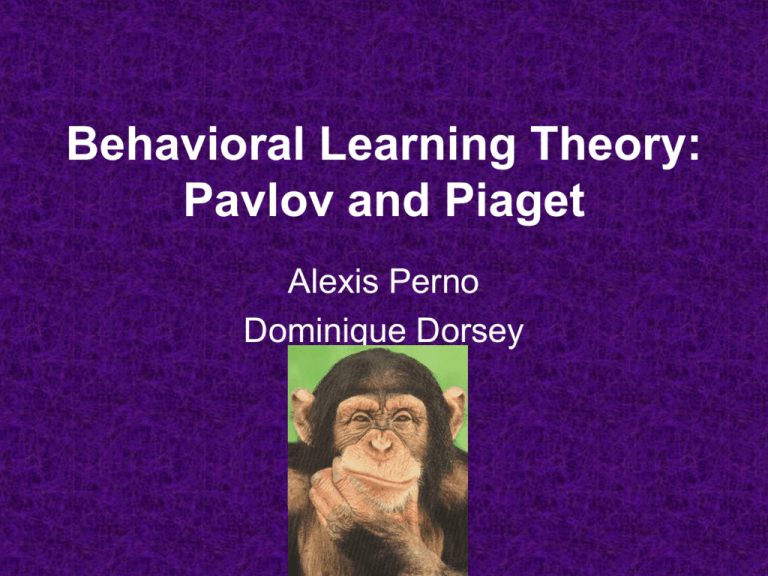
Behavioral Learning Theory: Pavlov and Piaget Alexis Perno Dominique Dorsey Behavioral Learning Theory According to the behaviorists, learning can be defined as “the relatively permanent change in behavior brought about as a result of experience or practice.” Behaviorists recognize that learning is an internal event. However, it is not recognized as learning until it is displayed by overt behavior. Ivan Pavlov •Born on September 14, 1849 •In 1875 received the degree of Candidate of Natural Sciences. •He was awarded the Nobel Prize for Physiology or Medicine in 1904 for his work on digestive secretions. •Died Feb. 27, 1936 Classical Conditioning -Learning which has been acquired through experience. Pavlov called the unconditioned stimulus (US) and unconditioned response (UR), respectively. If the neutral stimulus presented along with the unconditioned stimulus, it would become a conditioned stimulus (CS). If the CS and the US are repeatedly paired, eventually the two stimuli become associated and the organism begins to produce a behavioral response to the CS. Pavlov called this the conditioned response (CR). Dog Experiment The original and most famous example of classical conditioning involved the salivary conditioning of Pavlov's dogs. During his research on the physiology of digestion in dogs, Pavlov noticed that, rather than simply salivating in the presence of meat powder, the dogs began to salivate in the presence of the lab technician who normally fed them. Pavlov called these psychic secretions. From this observation he observed that, if a particular stimulus in the dog's surroundings were present when the dog was presented with meat powder, then this stimulus would become connected with food and cause salivation on its own. In his initial experiment, Pavlov used a bell to call the dogs to their food and, after a few repetitions, the dogs started to salivate in reaction to the bell. In technical terms, the meat powder is considered an unconditioned stimulus (UCS) and the dog’s salivation is the unconditioned response (UCR). The bell is a neutral stimulus until the dog learns to associate the bell with food. Then the bell becomes a conditioned stimulus (CS) which produces the conditioned response (CR) of salivation after repeated pairings between the bell and food. http://nobelprize.org/educational/medicine/pavlov/ Jean Piaget •Born in Neuchâtel, Switzerland • Born on August 9, 1896 •In 1918, received his Doctorate in Science from the University of Neuchâtel •Received a number of honorary degrees. -one from the Sorbonne in 1946 -the University of Brussels and the University of Brazil in 1949 -one from Harvard in 1936. •Died in Geneva, September 16, 1980 Developmental Theory -The theory that there are stages of development. Piaget believes that people begin at the level of Sensory Motor, moving to Preoperational, then Concrete Operations and eventually reaching Formal Operations. Stages of Development • • • • Stage Characterised by Sensori-motor (Birth-2 yrs) Differentiates self from objects Recognizes self as agent of action and begins to act intentionally: e.g. pulls a string to set mobile in motion or shakes a rattle to make a noise Achieves object permanence: realizes that things continue to exist even when no longer present to the sense (pace Bishop Berkeley) Pre-operational (2-7 years) Learns to use language and to represent objects by images and words Thinking is still egocentric: has difficulty taking the viewpoint of others Classifies objects by a single feature: e.g. groups together all the red blocks regardless of shape or all the square blocks regardless of color Concrete operational (7-11 years) Can think logically about objects and events Achieves conservation of number (age 6), mass (age 7), and weight (age 9) Classifies objects according to several features and can order them in series along a single dimension such as size. Formal operational (11 years and up) Can think logically about abstract propositions and test hypotheses systematically Becomes concerned with the hypothetical, the future, and ideological problems Compare and contrast Similarities •Both deal with organisms •Both move along with time •Both reflect environmental roles Differences • Pavlov’s focus is on conditioning while Piaget’s is on natural developments. •Pavlov’s can be controlled while Piaget’s takes a span of time to observe. •Pavlov’s theory is shown through experience and Piaget’s is a one time experience per observation unit. Bibliography • http://darkwing.uoregon.edu/~moursund/M ath/developmental_theory.htm • http://www.learningandteaching.info/learni ng/piaget.htm • http://piaget.org/ • http://nobelprize.org/nobel_prizes/medicin e/laureates/1904/pavlov-bio.html • http://www.ivanpavlov.com/
